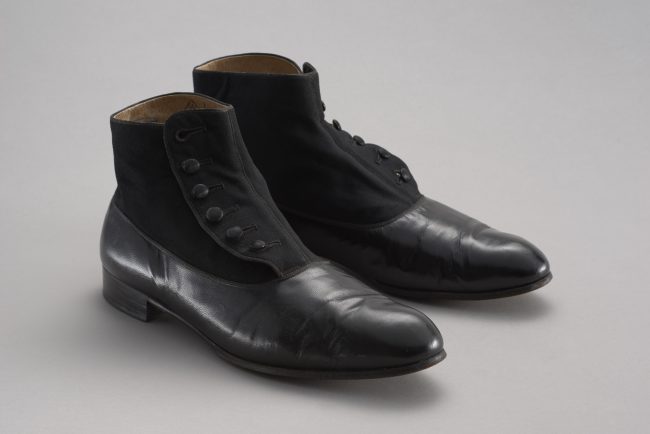
Men’s ankle boots fastened with buttons
The men’s ankle boots have a lacquered instep and a high rep upper fastened with a row of semispherical buttons. Such type of footwear is sometimes called “Poirot,” with reference to Hercule Poirot, the protagonist of Agata Christie’s (1890–1976) detective novels, who adhered to old-fashioned elegance. The indication of the maker – the company of Jan Kielman, is included in the stamp inside the upper, near the upper edge.
Jan Kielman’s shoemaker’s studio was established in 1883 on Chmielna Street. Aside from such companies as the workshops of Stanisław Hiszpański or Lucjan Leszczyński, it was one of the most exclusive studios in the capital city. Their products testified to the renown of Warsaw’s shoemakers, which was expressed in the adage about Poland’s greatest treasures: Toruń gingerbread, Kraków maids and Warsaw shoes. Kielman’s meticulously manufactured footwear soon found faithful clients. The company’s dynamic development was made possible by the immense market of Imperial Russia, within whose borders Warsaw was situated after the Partitions that took place between 1772 and 1795. On Chmielna Street, Kielman’s studio advertised its products in several shop windows. One of them featured a brass bath filled with water and with a shoe floating inside, thus demonstrating the durability of footwear manufactured by Kielman.
The company took pride in having one of the first neon signs in Warsaw. During the interwar period (1918–1939), the studio received many prestigious commissions. Its clients included Polish President Ignacy Mościcki (1867–1946), Generals Władysław Sikorski (1881–1943, Commander-in Chief of the Polish Armed Forces, Prime Minister of the Polish Government-in-Exile during World War II) and Charles de Gaulle (1890–1970, President of France), as well as numerous artists of such rank as famous tenor Jan Kiepura (1902–1966) and film star Mieczysława Ćwiklińska (1879–1972). In 1927, the studio delivered a very unconventional and prestigious commission: the ladies-in-waiting travelling with Afghan King Amanullah (1892–1960, King of Afghanistan 1926–1929) purchased around two hundred pairs of court shoes, as they were convinced they could not find better ones anywhere else. During his journey around Europe, the Afghan ruler established trade contracts for his personal needs and for the needs of the state. In Poland, he commissioned steam locomotives and a considerable number of women’s footwear.
The company relaunched its activity following the end of World War II as a small private shoemaker’s studio which resisted nationalisation. Nowadays, it is run by the fourth generation of the Kielman family, and the footwear manufactured under its brand enjoys renown in Poland and abroad. The studio offers luxury tailor and handmade shoes. The Museum holdings also include Kielman’s women’s court shoes from the 1940s.
Men’s ankle boots fastened with buttons
JAN KIELMAN CO.
WARSAW; EARLY 1930S
LACQUERED LEATHER, REP, COTTON CLOTH, PLASTIC BUTTONS,
MACHINE AND HAND-SEWN
MHW 23661/A–B
13,8 × 30 × 9 CM
Image licensed under: ![]()
